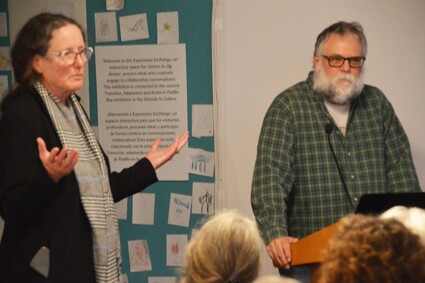66 birds/3 degrees lecture
January 24, 2024

Ken Stern
ARTIST AND SCIENTIST COLLABORATE, FINDING BEAUTY ENLARGES TRUTHS – Artist Natalie Niblack spent 14 months creating her exhibit, "66 Birds/3 Degrees." She and John Bower, an ornithology professor at Western Washington University, spoke to a full room at MoNA's second floor gallery Saturday, discussing "Inside an Artist & Scientist Collaboration: '66 Birds/3 Degrees.'" The Museum of Northwest Art exhibition, "Surge: Mapping Transition, Displacement and Agency in Times of Climate Change," closed Sunday, Jan. 21.
Saturday's lecture at the Museum of Northwest Art capped off the three-month visual and sound exhibition, "Surge: Mapping Transition, Displacement and Agency in Times of Climate Change," with a disturbing look at the future of birds. "If birds aren't doing well, we aren't either." said John Bower. He had collaborated with artist Natalie Niblack for their talk, "Inside an Artist & Scientist Collaboration: '66 Birds/3 Degrees,'" as they worked together for her exhibit. They spoke before a full room of over 50 people for the last educational program before the exhibition closed Jan. 21.
Niblack's 66 paintings of endangered birds wrapped the walls of the back first floor gallery accompanied by bird song.
Niblack enlisted Bower to write a description of each bird species detailing their struggles with climate change.
Bower focused on the future survival, mostly by migration, of Western Washington bird species through three degrees Celsius of climate change: 1.5-degrees, 2-degrees and 3-degrees. He based his talk on "Survival by Degrees: 389 Bird Species on the Brink" by the National Audubon Society listed birds as endangered or threatened in Western Washington.
Birds need particular habitat to nest in: to raise babies and to find safety from predators, high winds and heavy rain. Baby birds need protection from heat. And they need food. With forest fires, smoke and drought, all are threatened. With each increase in temperature degree, the threat of extinction increases.
Projecting future migrations by studying environmental conditions such as climate, vegetation, land use and topography; and combing the records of 140-million bird observation records from 604 species, Bower estimated the future geographic changes for each species.
Bower tapped into the National Audubon Society's website to share a detailed chart of the future of each bird, where it might migrate and where it will lose habitation.
Bower said 64% of the 604 species are moderately to highly vulnerable to climate change right now. Almost all, 97%, are vulnerable to two or more specific climate events combined, such as fire, drought, flood. There's been a pronounced shift already in summer and winter species ranges.
Anna's Hummingbirds are new to this area in the last thirty years. Bower predicted that a population of American white pelicans, wintering in Padilla Bay in recent years, will become a locally breeding population within five years. He made the point that even humans are migrating further north.
Mitigation could reduce vulnerability for 76% of the 604 Pacific Northwest birds based on these calculations but without taking into consideration other threats such as pollution, invasive species and changes in prey species populations.
Bower said a few scientists are seeing positive changes. The 2023 assessment put him in a "deep funk," but current assessments offer hope: if we do our part.
"Ultimately, If we save the birds, we save all of nature and ourselves," Niblack wrote for her exhibit's artist statement
We are already at 1.5 degree Celsius.
This exhibition was curated by Chloe Dye Sherpe.
Bower, a scientist, author and lecturer, is a professor at Western Washington University.
Niblack lives near Conway.







Reader Comments(0)